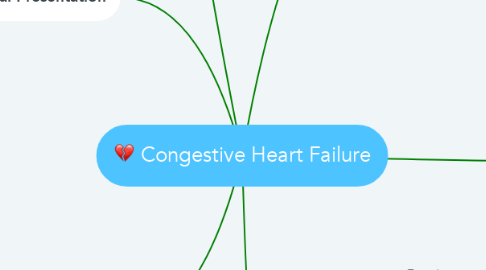Congestive Heart Failure
by Cindy White

1. Epidemiology
1.1. Approximately 5.7 million adults in the US have heart failure
1.2. Approximately half of the people who develop heart failure die within 5 years
1.3. The cost of heart failure is about $30.7 billion each year in the US
2. Clinical Presentation
2.1. Weight gain and edema in feet, ankles, legs, or abdomen
2.2. Orthopnea
2.3. Dyspnea with exertion
2.4. General malaise and weakness
2.5. Past Medical History of HTN, Diabetes, CAD
2.6. Paroxysmal Nocturnal Dyspnea
2.7. Audible S3 and S4
2.8. Pulmonary Crackles
3. Risk Factors
3.1. Hyperthyroidism, Diabetes, Hypertension, Anemia
3.2. CAD, MI, Arrhythmias, Aortic Stenosis
3.3. Smoking
3.4. High fat, cholesterol and sodium diet
3.5. Obesity
3.6. Inactive Lifestyle
3.7. Risk increases with age
4. Pathophysiology
4.1. The heart muscle is weak and it has difficulty circulating enough blood for adequate oxygenation
4.2. The heart wall is stressed which leads to myocyte hypertrophy, death and regeneration which causes eccentric remodeling
4.3. The abnormal remodeling puts more stress on remaining myocytes which causes progression of the damage
4.4. This leads to hemodynamic and neurohormonal changes and activate the neuroendocrine systems
4.5. Norepinephrine, epinephrine, endothelin-1, and vasopressin cause vasoconstriction and increased cyclic adenosine monophosphate and cytosolic calcium. The calcium enters myocytes and impairs myocardial relaxation
4.6. All these process cause increased energy expenditure and decreased cardiac output which causes myocardial cell death and sets off RAAS resulting in salt and water retention
5. Diagnosis
5.1. Basic Natriuretic Peptide Level
5.2. Chest X-ray
5.3. ECG or Echocardiograph
5.4. Clinical findings
6. Treatment
6.1. Treat the cause
6.2. Decrease sodium intake, possible fluid restriction
6.3. Oxygen as needed
6.4. Light physical activity on a regular basis
6.5. Symptom relief with diuretics, mitrates, or digoxin
6.6. Management of condition with ACE, Beta Blockers, ARB,
6.7. ICD, Valve repair, CABG, heart transplant depending on general health and age


